Address any questions or comments regarding this newsletter to the individual authors listed after each article or to its editors, Nathan Johanning, 618-939-3434, njohann@illinois.edu or Bronwyn Aly 618-695-6060, baly@illinois.edu. The Illinois Fruit and Vegetable News is available on the web at: http://ipm.illinois.edu/ifvn/. To receive or be removed from email notification of new postings of this newsletter, contact Nathan Johanning or Bronwyn Aly at the phone numbers or email addresses above.
In This Issue:
Upcoming Programs (listings for beginning and established growers)
News & Announcements (ded to the TeaAnother Local Foods Educator Adm, Food Marketing and Food Security Among Illinois Farmers)
Regional Reports (west central Illinois, southwestern Illinois, southern Illinois, Dixon Springs)
Fruit & Vegetable Production & Pest Management (New Required Training for Paraquat Herbicide Users,Record Keeping: Starting Off the Season Right)
Upcoming Programs
See the University of Illinois Extension Local Food Systems and Small Farms Team’s website at:
http://web.extension.illinois.edu/smallfarm/ and the calendar of events at http://web.extension.illinois.edu/units/calendar.cfm?UnitID=629.
- Illinois Farmers Market Association 2019-2020 Winter Webinars. If you are looking for great webinars that have a market focus check out this series from ILFMA and University of Illinois Extension. They are hosting one per month, between now and March 2020. Registration for the webinars listed below can be found here: Check it out! For more information, contact Laurie George ljgeorge@illinois.edu
- March 16, 2020 “The Future of Farmers Markets – Building Collaborative Practices”
- 2020 Small Farms Winter Webinar Series, Thursdays from 12-1pm, from January 30-March 26, 2020.
- To register and view expanded topic descriptions, visit go.illinois.edu/SmallFarmsWebinar
- March 5, 2020 Selling through Food Hubs and Co-ops: A Growers Perspective Laurie George
- March 12, 2020 Getting Started in Drip Irrigation Bronwyn Aly
- March 19, 2020 The Basics for Goats and Sheep James Theuri and Doug Gucker
- 2020 North American Raspberry and Blackberry Conference, Tuesday-Friday, March 3-6, 2020 in St. Louis, MO. Save the date and watch for conference registration very soon! https://www.raspberryblackberry.com/2020-north-american-raspberry-blackberry-conference/
Hotel accommodations can be made now. Here is the link for hotel information: https://www.raspberryblackberry.com/conference-accommodations/ Don’t miss the opportunity to attend this national conference and learn more about caneberry production!
- 2020 Live Local: Local Food and Farmers Market Annual Conference, Tuesday-Thursday, March 10-12, 2020 Embassy Suites, Peoria, IL. Specialty crop, small-scale farmers, small food businesses, and farmer’s markets face unique challenges and markets. Workshops and training opportunities allow them the chance to gain new skills, expand business, and connect with others facing similar challenges. Our Live Local Conference will help food businesses learn how to increase profits, develop a sustainable business, and grow market demand to build long-lasting family farms and businesses. For more information and to register online, visit http://www.ilfb.org/livelocal by March 3, 2020. FSMA produce safety training and certification being offered at this event.
- Annie’s Project (AP) Facilitator Training, April 8 & 9 at the University of Illinois Extension Office, 980 Postville Drive, Lincoln, Illinois 62656. This two-day workshop is for individuals that have an interest in becoming an Annie’s Project Facilitator, and/or a Managing for Today and Tomorrow Facilitator. Classes on both days will start at 8:00am. April 8th class will run until 4:30pm, and the April 9th class will end at 3:00pm. The cost for each class is $45.00 per person, and if interested in taking both classes, $90.00. Lunch will be included on both days. Registration closes on April 3rd and can be completed at the following link: https://go.illinois.edu/AnniesFacilitatorTraining. For more information contact Laurie George at (618) 242-0780 or ljgeorge@illinois.edu
News & Announcements
Another Local Food Systems and Small Farms Educator Added to the Team
Katie Bell has joined University of Illinois Extension as the Local Food Systems and Small Farms Educator serving Franklin, Jackson, Perry, Randolph and Williamson Counties. Katie is a native of Neoga, Illinois and two-time alum from Southern Illinois University. Bell received her bachelor’s degree in Agribusiness Economics with a minor in Crop Soils and Environmental Management and a master’s degree in Agribusiness Economics.
Katie has been involved with Extension having served as an intern from 2018 to 2019 where she worked at the Jackson County Extension Office and the Dixon Springs Agricultural Center. Katie has experience with high tunnel production, field production of vegetable crops including plasticulture and no-till production systems, and market pricing. As with our other new local foods team members, we are happy to have Katie on board and look forward to working with her as she builds her Extension program in southern Illinois. Welcome aboard, Katie!! Contact information for Katie Bell 618-687-1727 klbell@illinois.edu
Food Marketing and Food Security Among Illinois Farmers
Two students in the Food Science and Human Nutrition Department at the University of Illinois have developed a survey related to Food Marketing and Food Security among Illinois Farmers. They are gathering data on knowledge, practices, and approaches to create a baseline of information from which to develop programs and services. Please click on the following link if you would like to learn more about the project and participate in the online survey.
https://go.illinois.edu/illinoisfarmmarketingsurvey
Bronwyn Aly (618-382-2662; baly@illinois.edu)
Regional Reports
From west central Illinois (Macomb)…The current conditions from west-central Illinois have quite a bit of soil moisture. The soils are saturated. Even after days of weather above freezing, I still was slipping through the mud. Poorly drained areas have served my kids as impromptu ice-skating areas during freezing weather. A flock of geese is enjoying a shallow pond in the corn stubble behind my house. The precipitation this winter hasn’t been excessive, we are just still feeling the effects of the rainfall amounts from last fall. As I type, snow is falling but melting once it hits the ground. Snow will continue throughout the day with above-freezing temperatures and then we’ll dip back into winter weather. My least favorite part of winter is when ice and snow rest on top of the mud. Time to get the mop out.
As far as crops go, onions are going into high tunnels, mostly to make way for the flats of warm-season transplants. Beets are getting ready to go outside under plastic. Lettuces of all types are being hardened off. Spinach harvests continue for some growers, but I wonder if the warmer winter has affected growth and quality positively or negatively this year.
Chris Enroth (309-837-3939; cenroth@illinois.edu)
From southwestern Illinois (Waterloo)... We have been on the late-winter weather roller coaster in southern Illinois lately. We have gone from days near 60° to snow showers and everything in between. Precipitation has been moderate lately with a fair amount of cloudy days and fairly frequent rain/snow chances, but any precipitation we have received has been fairly light (under 0.5”). While the ground is still wet we have had some drying on top and unlike other years it is not completely saturated and muddy especially on more well drained areas. In the short term, we are supposed to be fairly warm with highs forecasted in the 50s & 60s for the upcoming week.
Winter pruning in orchard and other fruit crops has been on going. I have seen hedgers and pruning crews out over the last few weeks. It’s also time to be thinking about dormant oil and Sulforix and various fruit crops before bud break. In vegetable fields, it may not be too far off to be thinking about doing rough spring tillage like plowing or chisel plowing in preparation for plastic or root crops. Around here if we has a fairly mild, dry week with some wind I think we could be close at least for some rough tillage.
Cover crops are really starting to perk up and with some nice weather growth will really take off. Be thinking about how you want to manage any cover crops you have out. I would first consider what is going there (tillage for plastic vs no-till, etc) and that might determine how long you leave the cover crops until you terminate them. Remember as grains like cereal rye get taller (especially over 18” tall) they start to tie up a lot of nitrogen. This N is contributed back as organic matter to improve your soil and slowly re-release to your crops, but often it is not available early in the season so if you incorporate a lot of residue in your soil make sure you are amending with nitrogen and monitoring the crop. Spoon feeding with drip irrigation can be a great way to tailor your crop needs especially if you have concerns about cover crop residue. I usually don’t ever feel that an area with grain cover crops needs significantly higher N rates across the season, but often you do need to ensure adequate N upfront at planting and in the early weeks of growth. Also, if you are under overly wet conditions living cover crops will help to pull and draw moisture out of the soil as well. There are many specific situations and considerations depending on your specfic situation; feel free to reach out if you have any specific questions/thoughts about your field/crop situation.
I’d like to take a moment to personally welcome, Katie Bell into our Extension team. She is serving in my old position in Murphysboro after my move up to the Waterloo office. Katie has had the chance to work with both Bronwyn and I as and intern. She has a great skill set and is eager to learn and meet more growers as she develops her own, new Extension program in Murphysboro and the surrounding counties. Feel free to reach out and introduce yourself to her! I look forward to working with Katie on the team!
Nathan Johanning (618-939-3434; njohann@illinois.edu)
From southern Illinois…Hi everyone, my name is Katie Bell and I am the new Local Foods/Small Farms Educator for Unit 26. I have spent the last two summers interning for Extension at the Jackson County office and at the Dixon Springs Ag Center. I am excited for spring and I hope that everyone has a great 2020 growing season. Here at the Jackson County office we are readying the beds in our high tunnel for spring planting. This week we filled the beds with compost and will be tilling them soon. We hope to get a cover crop of oats up to help keep the weeds under control until we can steam the beds. Seedlings have been started on the heating mat, and they are looking good. The high tunnel will soon be filled with zinnias, snapdragons, leeks, onions, and much more!
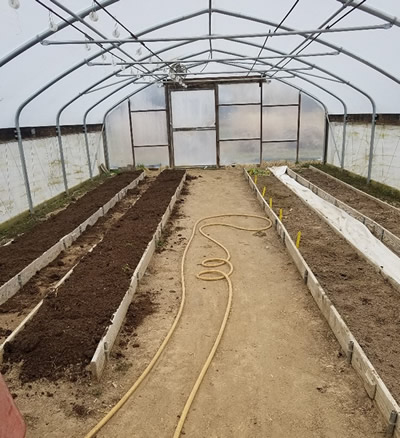
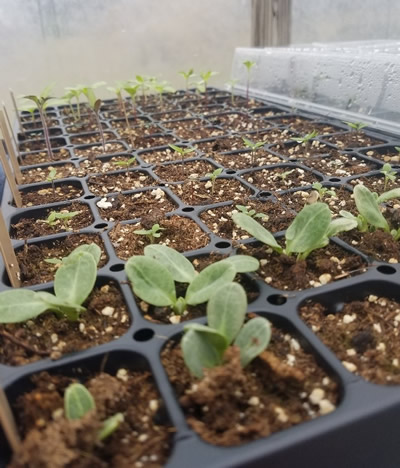
Photos by K. Bell. Left: Compost being added to the permanent raised beds in high tunnel at Jackson County Extension office. Right: Seedling have been started for transplant into the high tunnel in the next few weeks.
Katie Bell (618-687-1727; klbell@illinois.edu)
From Dixon Springs Ag Center…To spite these drury, cloudy rainy days, we are getting seedlings started and potting up bare root strawberry plants for the 2020 growing season. We are working to get the hydroponic tunnel and the empty ground bed tunnel ready for planting. We will be adding compost to the raised beds to replenish organic matter and keep the permanent beds full. We will also be steaming the beds to aid in weed and disease control. In the hydroponic tunnel, plastic along one of the side walls will be replaced as the orginal plastic finally had enough wear that it began to rip along the wiggle wire channel along the baseboard. Vertical strawberry stacks will be put back up and prepped for planting in a couple of weeks. Also, the NFT lettuce table will get fired up in the next couple of weeks with starts of lettuce, bok choi, pak choi, and spinach. Dutch buckets have been emptied, cleaned and sanitized and are ready for planting once our transplants are ready.
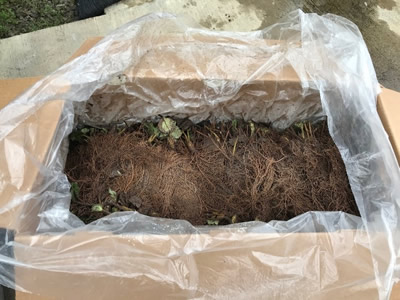
Bare root ‘Monterey’ strawberry plants arrived a couple of weeks ago. This box of 1000 plants has been stored in our cooler (but refrigerator will work also) and we can take out plants as needed and keep the rest in the cool until ready for more planting. These plants will eventually be put into the hydroponic vertical stacks but we like to pot them up and get them started in the greenhouse for a couple of weeks, just to give them a quicker start was they hit the stacks. Photo by B. Aly.
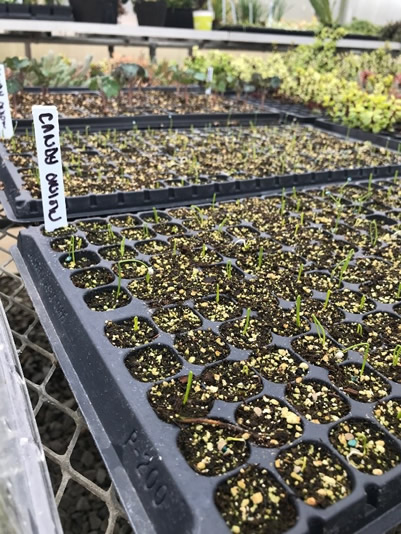
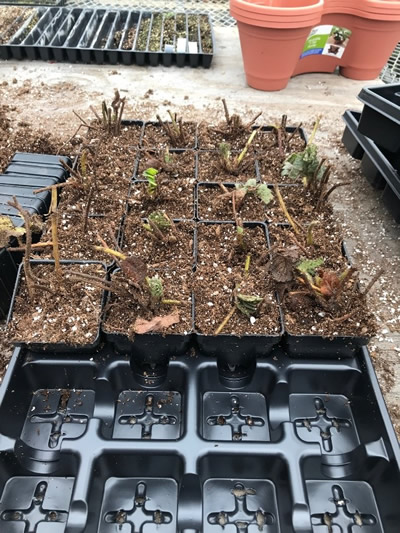
Photo on left: Onion seeds get an early start in the greenhouse and will be ready to transplant in early April. Our experience from the last couple of years has been that onions are ready to harvest around the first week of July. Photo on right: Bare root strawberry plants being potted up in preparation of planting in the high tunnel in a couple of weeks. Photos by B. Aly.
Harvest of spinach and kale is still underway in the winter production high tunnel. All of the head lettuce has been harvested and only one plot of the cut and come again salad mix is still in production. We have had to control for aphids over the winter, as the plots with row cover have maintained a pleasant environment for the critters during the few cold snaps throughout the winter. We will be harvesting the October planted carrot plots tomorrow and the final planting of carrots was direct seeded on February 5, 2020.
Kale and spinach plots in the winter production high tunnel at DSAC. Plots in the far two beds were transplanted the first week of November 2019 and the closest bed with black plastic have plots that were transplanted the first week of October 2019. Harvest is continuing on plots from both of these planting dates as plant leaves reach the minimum size outlined in the research protocol. Photo by B. Aly.
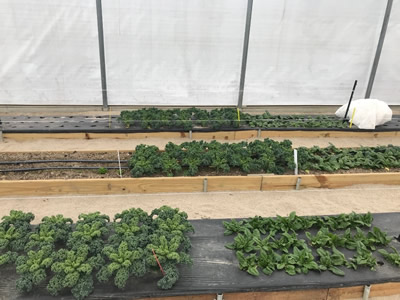

October 2019 seeded carrot plot ready for harvest.
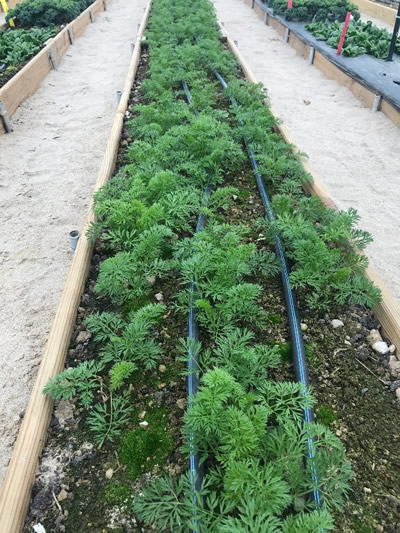
November 2019 seeded carrot plot. Some top growth but not ready for harvest.
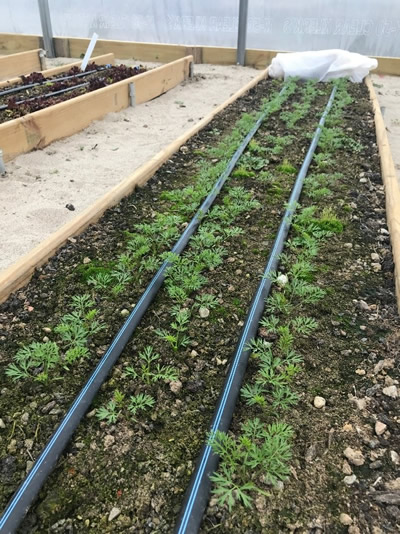

December 2019 seeded carrot plot on left that has just started a bit of top growth. January 2020 seeded carrot plot on right shows seeds have just germinated and broken through soil surface with still no true leaves noticeable. All four carrot plot photos were taken on February 24, 2020 by B. Aly.
Bronwyn Aly (618-382-2662; baly@illinois.edu)
Fruit & Vegetable Production & Pest Management
New Required Training for Paraquat Herbicide Users
For users of paraquat (Gramoxone, Firestorm, Parazone & other generics) there are some new restrictions and required trainings for purchase and use of this product. Now you will need to complete a free, online training with a short quiz in order to purchase new product. The training can be found at www.usparaquattraining.com. This training largely covers the safe handling of this product to insure safe use of the product.
Also, with this comes some changes in product packaging. As of the new product produced for 2020 it will be in a “closed system packaging” in either 2.5 gal containers or in bulk shuttles. This “closed system” will directly connect to a special adapter that can be added to sprayer lids/tanks where the product can be proportioned out with out the handler having to come into open contact with the product. On the new product label, spot sprayer or backpack sprayer applications will no longer be an option. Name brand “Gramoxone” made by Syngenta will now be formulated as 3 lb ai/gal compared with the former material which was 2 lbs ai/gal. This was to reduce the amount of product to handle and thus lower use rates. Note paraquat products are already and still are restricted use pesticides (RUP), requiring a pesticide applicator license to purchase.
Most of these transitions have all come about after the standard, periodic review the EPA did of the herbicide chemistry and these provisions were in place to meet these new safety requirements. Growers may still see “old stock” of paraquat products sold, but if not now, by later this year the new supply should be on most retailer shelves. I do not know all of the details of the “closed system” and how that will look but it was something that should be easily adapted to most sprayers and the required connectors should be available or sourced through your retailer. Some of these details are still changing so this is what I know as of now and we will share any further updates as I know more.
Nathan Johanning (618-939-3434; njohann@illinois.edu)
Record Keeping: Starting Off the Season Right
Over the next few months we will see our outside activities really ramp up as we prepare for the 2020 growing season. Most of us have probably spent the last few months pouring over the seed catalogs and inventorying supplies. While it is easy to get caught up in all the other tasks that go into running a produce farm, you should take this time at the beginning of the season to think about keeping accurate records of expenses, sales, and other operations information. If you are anything like me, you start out with the best of intentions to keep everything organized and accounted for, but it always ends up getting put off until “next year”.
Now is the perfect time to start off on the right foot with farm record keeping. If two thirds of your income is generated by on-farm activities, you have most likely done your farm taxes for the 2019 season, BUT if you haven’t gotten them in yet you have until March 2nd this year. While you have all of those numbers spinning around in your head, this is the perfect opportunity to think about your bookkeeping system, what you liked and didn’t like. Many of us have a general idea of what our expenses are and how much income we should be generating to keep the business going for another season; but it can be beneficial and even profitable to get exact numbers written down and organized in an understandable format.
There any many ways to keep records, and the size and diversity of your farm will determine what method works best for you. You may be able to keep good records by simply keeping all your receipts in a shoebox and writing down sales in a notebook, or you may need to invest in a bookkeeping software or even employ an accountant. When choosing a recordkeeping system here are a few things to consider:
- How many products do I sell? Is it only fresh produce or do I also sell value added products like jam?
- How many crops do I grow?
- How big is my operation, do I have multiple farms or rent land?
- Is this my main source of income or do I have other jobs?
- How many employees do I have, and do they work all year, seasonally, or a mix of both?
- How do I sell my products, direct market, wholesale, online?
- How do my customers pay cash, card, or payment apps?
This is only a small portion of questions to ask yourself when considering a good record keeping system. For example, if you grow fresh produce which you sell at various farmers markets and you hire the local high school kids to help with harvests and weed control, you may only need a good spreadsheet and some patience. On the other hand, if your operation is larger, you employ fulltime workers, produce both crops and value-added products, and you sell through multiple channels, a good bookkeeping software may be worth the investment.
Keep in mind, your main goal should be to keep track of your expenses and your income. Whatever system you choose should help you achieve this goal and be easy to understand. Microsoft Excel or Google sheets provide good spreadsheet options for basic record keeping. Cornell University provides a good Excel template to use for high tunnel production that could be adapted to most small farms https://smallfarms.cornell.edu/wp-content/uploads/2017/05/HT_Cornell_Account_Book_monthly-1nyhir8-1-19aa59h.xls . QuickBooks is good general bookkeeping software that is easy to use, but it does require a fee to use. There are also several free accounting software services that may be worth trying out, including Wave as an example. Fundera.com provides a list of the top eight free accounting software for small businesses at https://www.fundera.com/business-accounting/free-accounting-software#wave . If you are looking for something that is specific to farm record keeping you may want to look into Farmbrite https://www.farmbrite.com/farm-management.html or AgSquared https://www.agsquared.com/simple-farm , both of these options offer free trial periods before you have to pay for their service. The programs, software and services mentioned above are just a few examples of the numerous resources available to aid farmers in their small business record keeping endeavors and Extension does not endorse any of these over another or those not listed.
Only you can decide what system will work best for you and your farm, but any method of record keeping will go a long way to helping your business, reducing stress, and add to efficiency. I am also including a couple of links to information about farm taxes. This link takes you to the farmer’s tax guide put out by the IRS https://www.irs.gov/publications/p225 . Ruraltax.org provides tips and answers about farm taxes at https://ruraltax.org/small-farm-tax-guide .
Katie Bell (618-687-1727; klbell@illinois.edu)
Less Seriously
"What’s up doc?"?
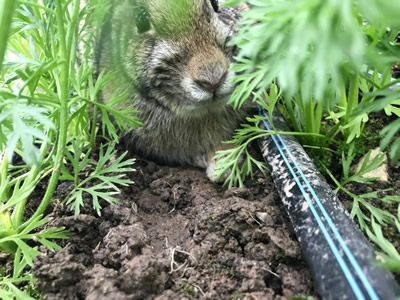
University of Illinois Extension Specialists in Fruit and Vegetable Production & Pest Management
Extension Educators – Local Food Systems and Small Farms |
||
Bronwyn Aly, Gallatin, Hamilton, Hardin, Pope, Saline, and White counties |
618-382-2662 |
|
Katie Bell, Franklin, Jackson, Perry, Randolph, & Williamson counties |
618-687-1727 |
|
Sarah Farley, Lake & McHenry counties |
847-223-8627 |
|
Nick Frillman, Woodford, Livingston, & McLean counties |
309-663-8306 |
|
Laurie George, Bond, Clinton, Jefferson, Marion, & Washington counties |
618-548-1446 |
|
Zachary Grant, Cook County | 708-679-6889 | |
Doug Gucker, DeWitt, Macon, and Piatt counties |
217-877-6042 |
|
Erin Harper, Champaign, Ford, Iroquois, and Vermillion counties |
217-333-7672 |
|
Grace Margherio, Jackie Joyner-Kersee Center, St. Clair County |
217-244-3547 |
|
Grant McCarty, Jo Daviess, Stephenson, and Winnebago counties |
815-235-4125 |
|
Katie Parker, Adams, Brown, Hancock, Pike and Schuyler counties |
217-223-8380 |
|
Kathryn Pereira, Cook County |
773-233-2900 |
|
James Theuri, Grundy, Kankakee, and Will counties |
815-933-8337 |
|
Extension Educators – Horticulture |
||
Chris Enroth, Henderson, Knox, McDonough, and Warren counties |
309-837-3939 |
|
Richard Hentschel, DuPage, Kane, and Kendall counties |
630-584-6166 |
|
Andrew Holsinger, Christian, Jersey, Macoupin, & Montgomery counties |
217-532-3941 |
|
Extension Educators - Commercial Agriculture |
||
Elizabeth Wahle, Fruit & Vegetable Production |
618-344-4230 |
|
Nathan Johanning, Madison, Monroe & St. Clair counties |
618-939-3434 |
|
Campus-based Extension Specialists |
||
Kacie Athey, Entomology |
217-244-9916 |
|
Mohammad Babadoost, Plant Pathology |
217-333-1523 |
|